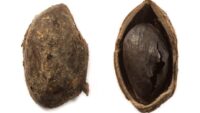Archaeologists have unearthed an imposingly large and detailed phallus carving in Catterick, North Yorkshire. Carved out of local red sandstone, the 11-inch phallus is artfully modelled in high relief. The shaft features an unusual herringbone pattern and a line of erupting ejaculate. It is one of more than 62,000 archaeological objects and remains discovered over more than three years of excavations in advance of improvements to the A1 highway.
The modern A1 in North Yorkshire follows the route of the ancient Roman Dere Street, the main road from York to the Antonine Wall at the Firth of Forth. The road was well-traveled and dotted with Roman settlements, including the town of Cataractonium, aka Catterick. Investigations took place between 2013 and 2017 and revealed a great deal about Cataractonium’s history that was previously unknown. The deep archaeological layers contained clearly stratified evidence of the settlement’s history going back to its earliest days.
Archaeologists discovered that Cataractonium was entirely of Roman origin with no previous British occupation. It was founded in the 70s A.D. as a  civilian vicus attached to a Roman military fort. It expanded rapidly and by the early 2nd century was a large, flourishing town supplied with granaries, stock paddocks and a deep well. A pistachio nut perfectly preserved in the well’s waterlogged environment dates to the Trajanic period (late 1st, early 2nd century A.D.) and is the oldest pistachio ever discovered in Britain.
civilian vicus attached to a Roman military fort. It expanded rapidly and by the early 2nd century was a large, flourishing town supplied with granaries, stock paddocks and a deep well. A pistachio nut perfectly preserved in the well’s waterlogged environment dates to the Trajanic period (late 1st, early 2nd century A.D.) and is the oldest pistachio ever discovered in Britain.
Timber structures predominated in Cataractonium, but in the early 3rd century old wood structures were replaced by masonry in what archaeologists believe was planned urban development program. The carved phallus was involved in that process not once but twice.
When it was found by archaeologists, it was being used as a floor paver in a building at Agricola Bridge. It was originally a bridge abutment stone, however, its prodigious apotropaic load deployed to protect travelers crossing the Swale river. This was not unusual in Roman bridge architecture (or any other architecture, for that matter). There’s one still in situ on an abutment of the Chesters Bridge over the River North Tyne at Chesters Roman fort on Hadrian’s Wall. The structure of the bridge is no longer extant, but large blocks of stone identified as bridge stones were found on the slope of the riverbank.
All of the finds discovered during the A1 excavations, from pistachio nuts to phallus, carnelian intaglio of Hercules killing the Nemean lion to three tons of animal bone, 2.5 tons of pottery and several more tons of stonework, are now at the Yorkshire Museum in York. They will be studied further, conserved and stored. A few select pieces will eventually go on display.

I didn’t know the Romans practiced circumcision.
The term “circumcisio” is in fact Latin. The Roman garrison of Praeputium, however, should be found in what today is Scotland.
:hattip:
OK, I just can’t resist commenting to “Virginia”, a name too appropriate. The glans of an erect uncircumcised penis extends beyond the foreskin and therefore the depiction of such a penis would appear circumcised. There is no reason to conclude from this carving that Romans practiced circumcision. If you want to start a debate on circumcision, I’m ready to go!
Can you share a link to the Highways England article or pdf that included the phallus photo? I am not very surprised that the popular press seems to have shrunk from reprinting it in their coverage.
O tempora, o mores.
Looks just like Jeff Bezos’s spaceship! 😆
Well, this is an interesting story and comments! It wouldn’t have to be a circumcised penis as it is erect and ejaculating.
Also has to be the first story in history to have “penis” and “pistachio” in the same sentence.